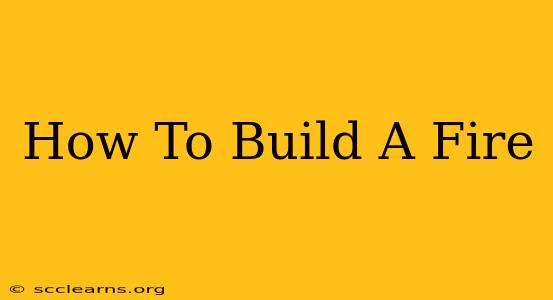Building a fire might seem simple, but mastering the art takes practice and understanding. This guide covers everything from choosing the right location and materials to mastering different fire-building techniques, ensuring you can confidently build a roaring fire for warmth, cooking, or simply enjoying the ambiance.
Choosing Your Location: Safety First
Before you even think about striking a match, safety is paramount. Consider these crucial factors when selecting your fire pit or building site:
- Clear the area: Remove any dry leaves, twigs, or flammable materials within a 10-foot radius. This prevents accidental spread and keeps your fire contained.
- Check for wind: Wind can quickly spread embers, so choose a location sheltered from strong gusts.
- Water source: Have a bucket of water or a hose nearby to extinguish the fire completely when finished. Never leave a fire unattended.
- Regulations: Check local regulations and fire bans before starting any fire. Many areas have restrictions, especially during dry periods.
Gathering Your Materials: The Fuel Trinity
Building a successful fire relies on understanding the three key components: tinder, kindling, and fuelwood.
1. Tinder: The Spark Starter
Tinder is the easily combustible material that catches the initial spark and ignites the flame. Excellent tinder options include:
- Dry leaves: Crumpled, dry leaves are readily available and burn quickly.
- Birch bark: Known for its thin layers and easy flammability.
- Pine needles: Fine and easily ignited.
- Commercial fire starters: Convenient and reliable options.
- Cotton balls dipped in petroleum jelly: A classic and highly effective method.
2. Kindling: Building the Bridge
Kindling acts as the bridge between the tinder and the fuelwood. These are small, dry twigs and branches that gradually increase in size, gradually transferring the flame from the tinder to the larger pieces. Look for:
- Small twigs: Pencil-lead thickness.
- Slightly larger branches: About finger-thickness.
- Gradually increasing sizes: Create a teepee structure to allow for airflow.
3. Fuelwood: The Main Event
Fuelwood is the main source of sustained heat and combustion. Select dry, seasoned wood for optimal burning. Good choices include:
- Hardwoods: Oak, maple, and hickory burn longer and hotter.
- Softwoods: Pine and fir burn quicker and are ideal for starting a fire or for quick cooking. Avoid green or damp wood, which will produce smoke and take longer to ignite.
Building Your Fire: Techniques and Tips
There are several effective ways to build a fire; here are two popular methods:
The Teepee Method:
This is a simple and effective technique, especially for beginners.
- Build a small teepee: Arrange the tinder in a small cone shape in the center of your fire pit.
- Add kindling: Lean small twigs against the tinder, creating a teepee structure. Leave space for airflow.
- Gradually increase kindling size: As the kindling catches fire, add progressively larger pieces.
- Add fuelwood: Once the kindling is burning well, add larger pieces of fuelwood, maintaining the teepee shape.
The Log Cabin Method:
This method is ideal for larger fires and provides excellent stability.
- Lay two pieces of kindling parallel: Create a base.
- Cross two more pieces on top: Forming a square or rectangle.
- Continue layering: Building a small log cabin structure, gradually increasing the size of the pieces.
- Add tinder in the center: Place tinder in the center and light.
- Add fuelwood: Once the kindling catches fire, add larger pieces of fuelwood on top.
Extinguishing Your Fire: Responsibility is Key
Extinguishing a fire correctly is just as important as building it. Follow these steps to ensure complete extinguishment:
- Douse with water: Slowly pour water over the embers, stirring with a shovel or stick to ensure all embers are soaked.
- Stir and check: Continue adding water and stirring until the ashes are cool to the touch.
- Monitor: Watch the area for several hours to ensure no embers reignite.
By following these steps and practicing regularly, you'll confidently build and manage fires in any situation. Remember, safety and responsible fire management are always the top priorities.

